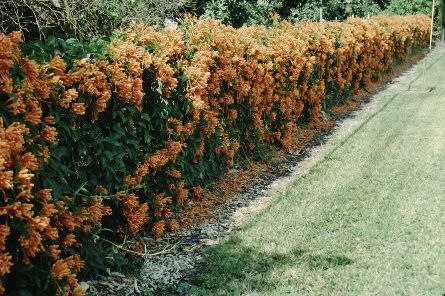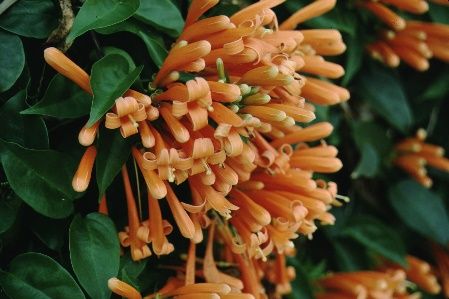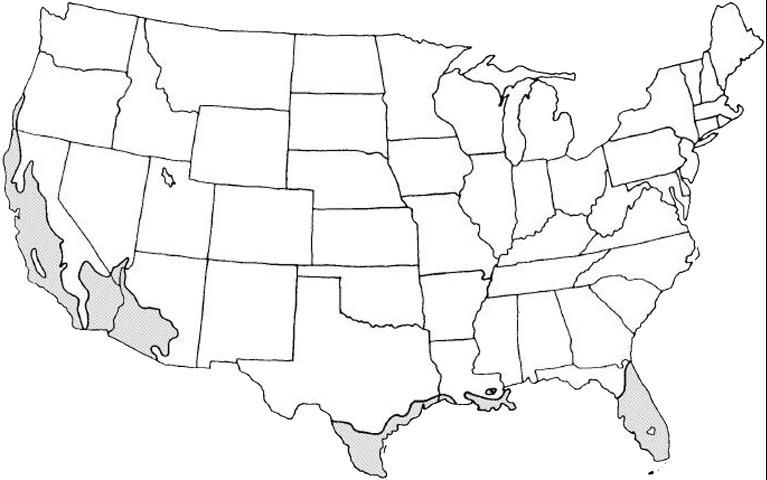Introduction
Also known as Pyrostegia ignea, Flame Vine grows rapidly. Climbing by tendrils, this vigorous evergreen vine makes a brilliant fall and winter display of reddish orange, 3 inch long tubular flowers borne in clusters of 15 to 20. Covering everything that can offer a good support, flame vine should be planted with caution because it has been known to cover, then strangle, trees with its rampant growth. It has escaped cultivation in much of central Florida and is often seen in flower during the winter and spring, growing in trees. It can be found occasionally in the southern parts of hardiness zone 8b. Heavy or frequent pruning is needed to restrain it to trellises or arbors, but the brilliant flower display makes this extra work worth the effort. It is ideal for covering fences but will often produce most of the flowers and foliage at the top of the fence. Regularly heading back several of the stems can help develop some of the flowers and foliage on the lower and middle portions of the fence.

Credit: Edward F. Gilman, UF/IFAS

Credit: Edward F. Gilman, UF/IFAS

Credit: Edward F. Gilman, UF/IFAS
General Information
Scientific name: Pyrostegia venusta
Pronunciation: pye-roe-STEEG-ee-uh ven-NUSS-tuh
Common name(s): flame vine, flame flower, flamingo trumpet
Family: Bignoniaceae
Plant type: vine
USDA hardiness zones: 9 through 11 (Figure 4)
Planting month for zone 9: year-round
Planting month for zone 10 and 11: year-round
Origin: native to South America
Invasive potential: not considered a problem species at this time and may be recommended by UF/IFAS faculty (reassess in 10 years)
Uses: espalier
Availability: somewhat available, may have to go out of the region to find the plant

Credit:
Description
Height: depends upon supporting structure
Spread: depends upon supporting structure
Plant habit: spreading
Plant density: dense
Growth rate: fast
Texture: medium
Foliage
Leaf arrangement: opposite/subopposite
Leaf type: palmately compound
Leaf margin: entire
Leaf shape: ovate
Leaf venation: pinnate
Leaf type and persistence: evergreen
Leaf blade length: 2 to 4 inches
Leaf color: green
Fall color: no fall color change
Fall characteristic: not showy
Flower
Flower color: orange
Flower characteristic: winter flowering; fall flowering
Fruit
Fruit shape: elongated
Fruit length: 6 to 12 inches
Fruit cover: dry or hard
Fruit color: unknown
Fruit characteristic: inconspicuous and not showy
Trunk and Branches
Trunk/bark/branches: usually with one stem/trunk
Current year stem/twig color: brown
Current year stem/twig thickness: thin
Culture
Light requirement: plant grows in part shade/part sun
Soil tolerances: alkaline; clay; sand; acidic; loam
Drought tolerance: high
Soil salt tolerances: poor
Plant spacing: 36 to 60 inches
Other
Roots: not applicable
Winter interest: plant has winter interest due to unusual form, nice persistent fruits, showy winter trunk, or winter flowers
Outstanding plant: plant has outstanding ornamental features and could be planted more
Pest resistance: no serious pests are normally seen on the plant
Use and Management
Growing in full sun to partial shade, Flame Vine will tolerate a wide range of soils. Flame Vine sometimes flowers lightly during the summer.
Propagation is by cuttings or layering.
Pests and Diseases
Scales, caterpillars, and mites can be a problem for Flame Vine.